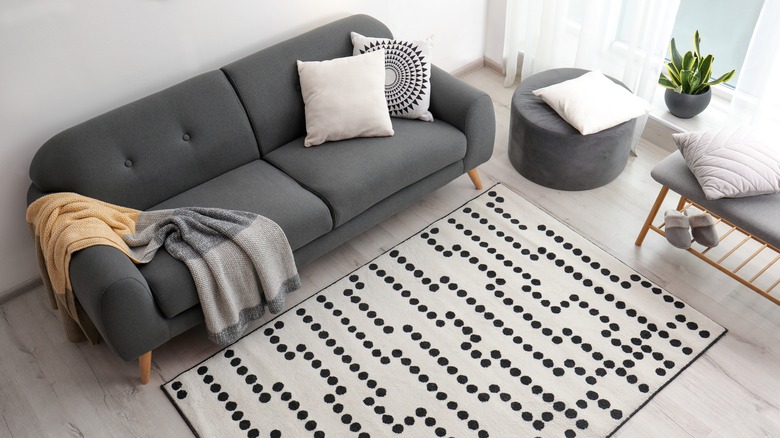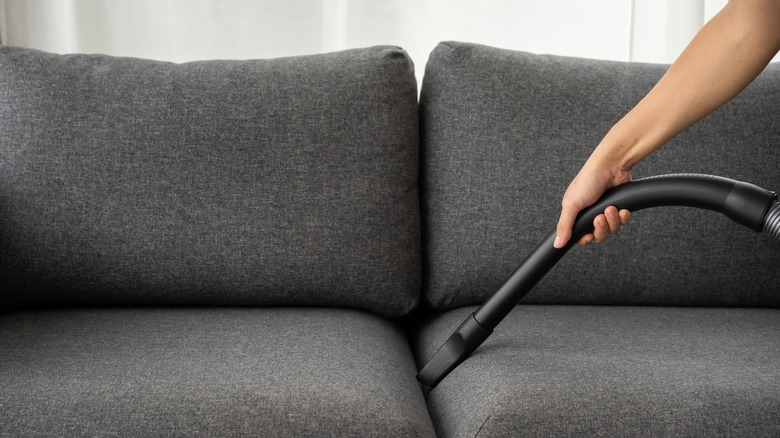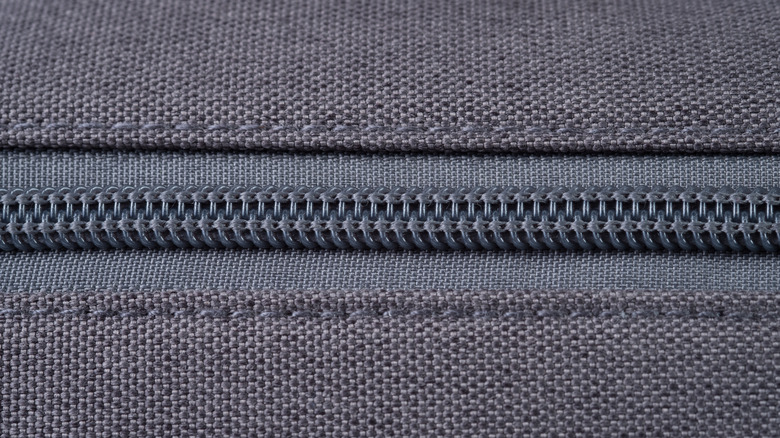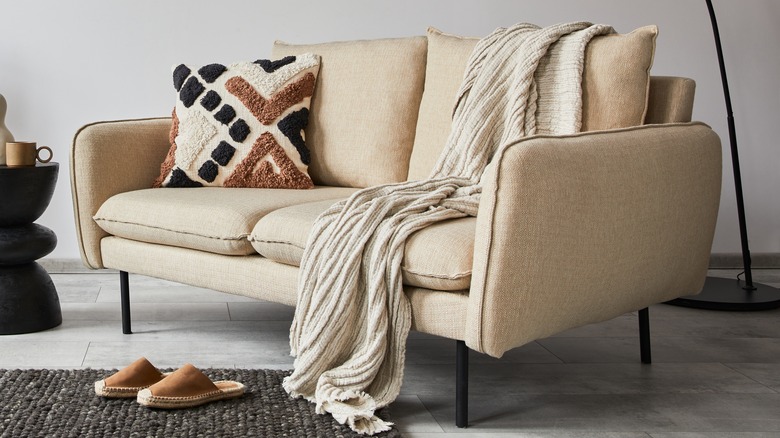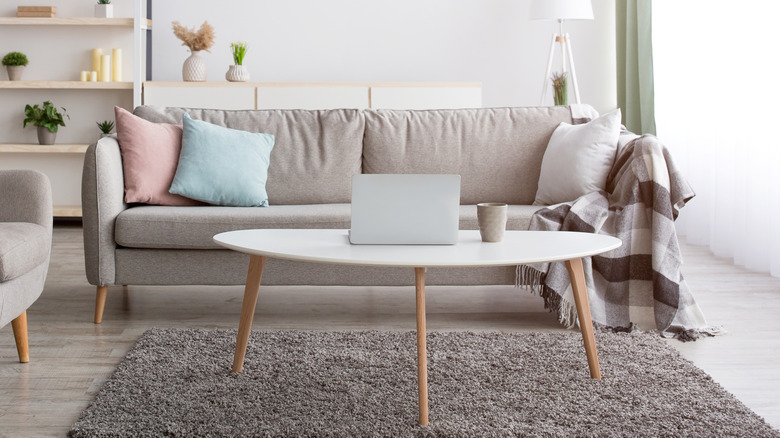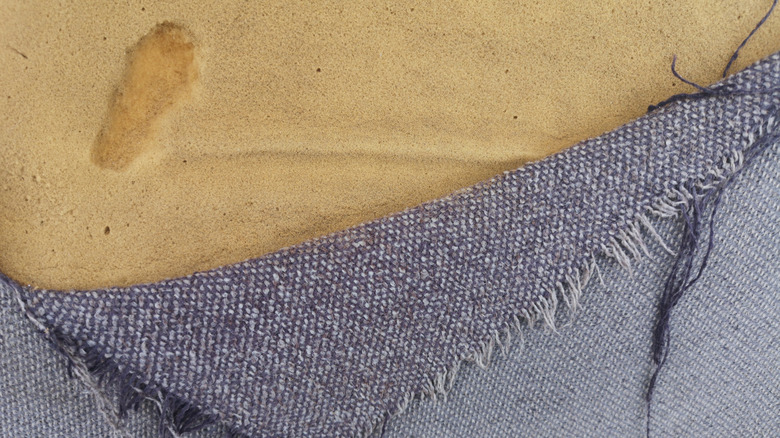5 Ways To Make Your Uncomfortable Couch Cozier
While most people own a couch, not everyone has a comfortable one. Even though this can vary from couch to couch, there are a few common reasons why your couch is uncomfortable. According to Housepoint, one of the main reasons is standard wear-and-tear. Over time, couches get worn out and tend to lose their shape, thus creating an unpleasant seating area. Another similar reason is the size of the sofa. If you get a couch that is too big or small or sits awkward, you might find that its intended purpose isn't suitable for your needs.
Additionally, the material from which the couch is made can have an impact. If the materials are on the cheap side, chances are it will not be comfortable for an extensive amount of time. This includes the cushion material as well as the base and the frame. If your model contains a footrest or ottoman, it may not fit parallel with how you're sitting, which can also cause discomfort. On the other hand, it may be something as simple as the wrong design or pillow shape. Sometimes the wrong size, shape, or material can throw off your whole setting without you realizing it.
Fortunately, there are many solutions to fix your sofa without having to buy another one. From adding pillows to reshaping cushions, here are five ways to make your uncomfortable couch cozier.
1. Give it a deep cleaning
First and foremost, give your couch a thorough cleaning. As per Martha Stewart, the founder of BenchMade Modern, Edgar Blazona, recommends doing a deep cleaning every six months. However, in between these cleanings, he also recommends doing a standard weekly cleaning, such as vacuuming the cushions. Aside from these cushions, you can also vacuum the inside of the couch as much as possible. Pro Housekeepers also recommend taking a firm brush to wipe away any crumbs or debris. You may need a pair of tweezers or another small device to get into hard-to-reach areas.
If you want to be even more thorough, you can turn your sofa upside down to see if anything falls out. In doing so, you may find items that you have lost, such as a remote, dog toy, or trash. Believe it or not, these items can cause extreme discomfort that may make your cushions sit in an awkward position. Once you've cleaned it all up, place your couch back together and see how it feels. If it feels better, great! If not, you may need to try a few other methods.
2. Reshape cushions and pillows
Another simple task that may help your sofa is reshaping your cushions and pillows. Sometimes, after sitting for long periods, the couch will lose its initial firmness, which can cause discomfort. However, fixing this can make you feel like you're sitting on a brand-new sofa. To do so, INSTUPIX says that by taking a glance at your couch, you'll quickly notice which areas are used more than others.
On the back of these cushions and pillows should be a zipper. This is where you can access the stuffing. Once open, fluff out the areas that are sagging. It might also be helpful to lightly fluff out the other areas just to get them even. Each item should take at least a minute or so to ensure it's as fluffed as possible. While this isn't the case for all cushions, many can be fixed with this easy tip.
There are a few other ways to fluff up your cushions too. According to YouTube, you can leave the cushions as they are and give them a little hit, shake, and squeeze. Sometimes a gentle nudge is all it needs to get back in shape. It is also recommended that you flip your cushions every week to ensure that the fluff is evenly distributed.
3. Add in tons of blankets and throw pillows
Most couches contain a variety of throw pillows and blankets, but if yours doesn't, adding these layers of comfort may be exactly what you need to make your couch cozier. Since you're adding something to your sofa, you can make this customizable. Everyone varies in what makes them comfortable, and pillows are no exception. For example, some may prefer stiff pillows, while others prefer soft and squishy styles. No matter what you prefer, add it to your couch and see if it's comfortable. Just make sure you style it correctly to not throw off the room.
According to Style by Emily Henderson, be consistent with the colors and patterns while varying the shapes and sizes of the pillows. While you should only have three to five colors total, scatter them across the sofa, so they're not all in one place. It might also be beneficial to add pillows of different textures to give the space more variety.
As for blankets, Tidbits & Twine suggests trying a few styles. The most popular way to style a blanket is to throw it over the arm of the couch. However, another equally popular style is placing the blanket on the back of the couch. This keeps it out of the way and provides extra back cushioning. While there are many other styles, don't be afraid to play around to find what's most comfortable for you that also fits the room's aesthetic.
4. Fix the height and pair it with other furniture
If the height of your couch is a comfort problem, consider adding bed risers underneath to raise it a bit. As per Home Steady, the standard seat height of a couch can range anywhere from 18 to 22 inches. If there are kids or short adults in the home, the best height for your sofa to sit at is 18 to 19 inches. This will make them more comfortable as their feet are more likely to touch the ground. A height of 20 or 21 inches is the size for average-sized adults. For those tall adults over 6 feet tall, you may need to raise your sofa up to 22 inches to ensure your knees and legs aren't cramped.
While this may not seem obvious, after fixing the height, pairing your couch with other furniture can provide more comfort than one might think. If you constantly work on projects from the comfort of your sofa, you may need to add a coffee table or end table to help. Preferably, this should be around the same size as the couch or slightly lower. Mindy Gayer also recommends leaving a walkable space at each end of the tables to create a level of comfort.
5. If all else fails: reupholster it
If all the above solutions don't work, a last resort option is to reupholster your couch. Of course, this will be expensive, so it might be cheaper just to buy a new couch. However, reupholstering may be your only option if you're attached to your current model or if it holds sentimental value. To complete this project, it is recommended that you DIY to save a bit of money. According to Master Class, you first need to remove any skirts or fabric underneath so you can access the material inside. It should be noted that there may be more than one layer, so remember which order the layers are in after you've finished the project.
Once all the fabric is out of the way, remove the cushioning on the inside. You'll then need to take measurements of the length, width, and depth to ensure you get the exact size cushioning you need. Take note of any indents made by the sofa so you can cut out these spots in the new cushioning. Next, you have to buy new material. Foam Factory sells a lot of pre-made cutouts of a variety of sizes, including standard sizes, rounded shapes, and arched cushions. Once you've brought your material, install it on the sofa and sew the fabric lawyers back on.
